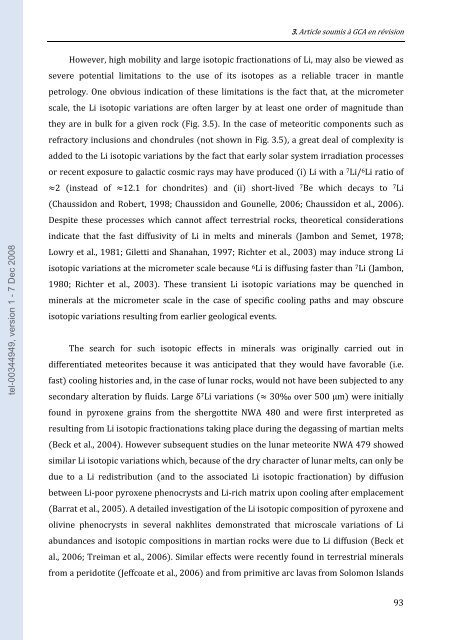Géochimie isotopique du lithium dans les basaltes-Géochimie des ...
Géochimie isotopique du lithium dans les basaltes-Géochimie des ...
Géochimie isotopique du lithium dans les basaltes-Géochimie des ...
You also want an ePaper? Increase the reach of your titles
YUMPU automatically turns print PDFs into web optimized ePapers that Google loves.
tel-00344949, version 1 - 7 Dec 2008<br />
3. Article soumis à GCA en révision<br />
However, high mobility and large isotopic fractionations of Li, may also be viewed as<br />
severe potential limitations to the use of its isotopes as a reliable tracer in mantle<br />
petrology. One obvious indication of these limitations is the fact that, at the micrometer<br />
scale, the Li isotopic variations are often larger by at least one order of magnitude than<br />
they are in bulk for a given rock �Fig. 3.5�. In the case of meteoritic components such as<br />
refractory inclusions and chondru<strong>les</strong> �not shown in Fig. 3.5�, a great deal of complexity is<br />
added to the Li isotopic variations by the fact that early solar system irradiation processes<br />
or recent exposure to galactic cosmic rays may have pro<strong>du</strong>ced �i� Li with a 7 Li/ 6 Li ratio of<br />
�2 �instead of �12.1 for chondrites� and �ii� short‐lived 7 Be which decays to 7 Li<br />
�Chaussidon and Robert, 1998; Chaussidon and Gounelle, 2006; Chaussidon et al., 2006�.<br />
Despite these processes which cannot affect terrestrial rocks, theoretical considerations<br />
indicate that the fast diffusivity of Li in melts and minerals �Jambon and Semet, 1978;<br />
Lowry et al., 1981; Giletti and Shanahan, 1997; Richter et al., 2003� may in<strong>du</strong>ce strong Li<br />
isotopic variations at the micrometer scale because 6 Li is diffusing faster than 7 Li �Jambon,<br />
1980; Richter et al., 2003�. These transient Li isotopic variations may be quenched in<br />
minerals at the micrometer scale in the case of specific cooling paths and may obscure<br />
isotopic<br />
variations resulting from earlier geological events.<br />
The search for such isotopic effects in minerals was originally carried out in<br />
differentiated meteorites because it was anticipated that they would have favorable �i.e.<br />
fast� cooling histories and, in the case of lunar rocks, would not have been subjected to any<br />
secondary alteration by fluids. Large δ 7 Li variations �� 30‰ over 500 μm� were initially<br />
found in pyroxene grains from the shergottite NWA 480 and were first interpreted as<br />
resulting from Li isotopic fractionations taking place <strong>du</strong>ring the degassing of martian melts<br />
�Beck et al., 2004�. However subsequent studies on the lunar meteorite NWA 479 showed<br />
similar Li isotopic variations which, because of the dry character of lunar melts, can only be<br />
<strong>du</strong>e to a Li redistribution �and to the associated Li isotopic fractionation� by diffusion<br />
between Li‐poor pyroxene phenocrysts and Li‐rich matrix upon cooling after emplacement<br />
�Barrat et al., 2005�. A detailed investigation of the Li isotopic composition of pyroxene and<br />
olivine phenocrysts in several nakhlites demonstrated that microscale variations of Li<br />
abundances and isotopic compositions in martian rocks were <strong>du</strong>e to Li diffusion �Beck et<br />
al., 2006; Treiman et al., 2006�. Similar effects were recently found in terrestrial minerals<br />
from a peridotite �Jeffcoate et al., 2006� and from primitive arc lavas from Solomon Islands<br />
93

















